International Construction Joint Ventures: Case Study Report
VerifiedAdded on 2023/06/03
|20
|5356
|76
Report
AI Summary
This report provides a comprehensive analysis of international construction joint ventures, focusing on the collaboration between international developers and government agencies. The study explores the reasons behind forming such ventures, including risk sharing, economies of scale, and market access. It examines the advantages and disadvantages of joint ventures, as well as the key factors influencing their success. The report includes detailed case studies of prominent projects such as the Delhi Metro Rail Project, the Eastlink Freeway Project, and the Metro Tunnel Project in Melbourne, and the Delhi Gurgaon Expressway Project. These case studies provide insights into the practical application of joint ventures, highlighting the contractual agreements, shared objectives, and management structures involved. The report also analyzes the economic, environmental, and cultural factors that affect these projects. The conclusion summarizes the key findings and offers recommendations for successful joint venture implementation.
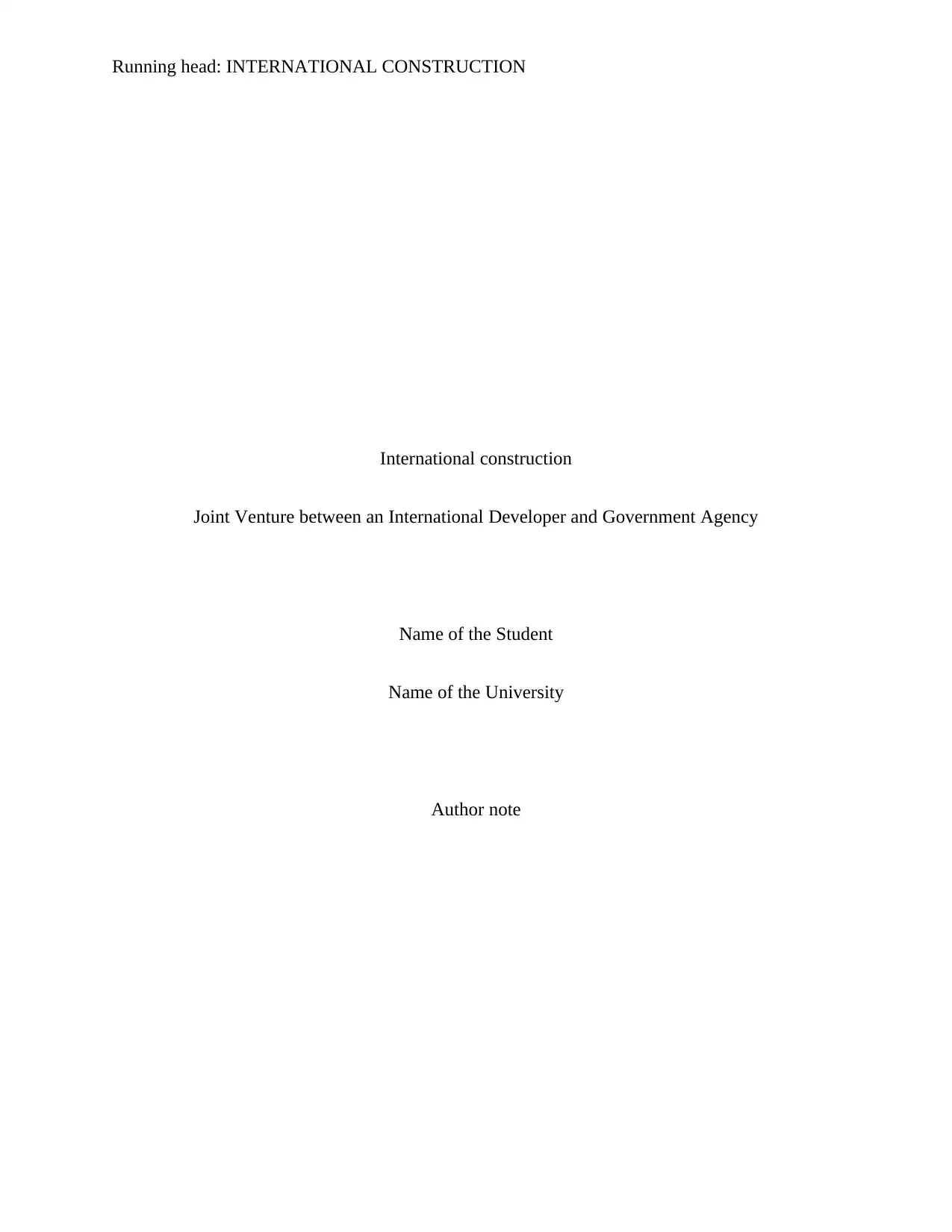
Running head: INTERNATIONAL CONSTRUCTION
International construction
Joint Venture between an International Developer and Government Agency
Name of the Student
Name of the University
Author note
International construction
Joint Venture between an International Developer and Government Agency
Name of the Student
Name of the University
Author note
Paraphrase This Document
Need a fresh take? Get an instant paraphrase of this document with our AI Paraphraser
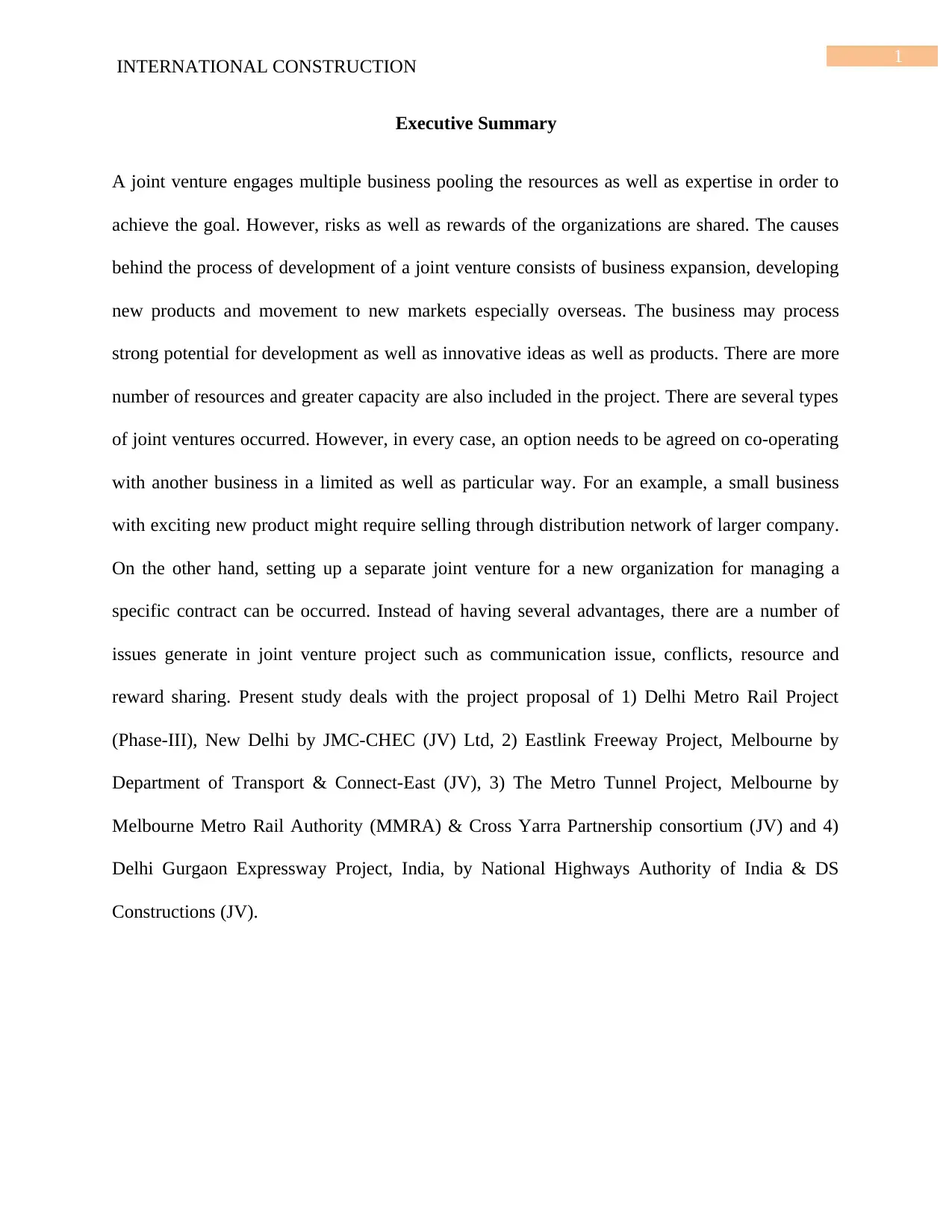
1
INTERNATIONAL CONSTRUCTION
Executive Summary
A joint venture engages multiple business pooling the resources as well as expertise in order to
achieve the goal. However, risks as well as rewards of the organizations are shared. The causes
behind the process of development of a joint venture consists of business expansion, developing
new products and movement to new markets especially overseas. The business may process
strong potential for development as well as innovative ideas as well as products. There are more
number of resources and greater capacity are also included in the project. There are several types
of joint ventures occurred. However, in every case, an option needs to be agreed on co-operating
with another business in a limited as well as particular way. For an example, a small business
with exciting new product might require selling through distribution network of larger company.
On the other hand, setting up a separate joint venture for a new organization for managing a
specific contract can be occurred. Instead of having several advantages, there are a number of
issues generate in joint venture project such as communication issue, conflicts, resource and
reward sharing. Present study deals with the project proposal of 1) Delhi Metro Rail Project
(Phase-III), New Delhi by JMC-CHEC (JV) Ltd, 2) Eastlink Freeway Project, Melbourne by
Department of Transport & Connect-East (JV), 3) The Metro Tunnel Project, Melbourne by
Melbourne Metro Rail Authority (MMRA) & Cross Yarra Partnership consortium (JV) and 4)
Delhi Gurgaon Expressway Project, India, by National Highways Authority of India & DS
Constructions (JV).
INTERNATIONAL CONSTRUCTION
Executive Summary
A joint venture engages multiple business pooling the resources as well as expertise in order to
achieve the goal. However, risks as well as rewards of the organizations are shared. The causes
behind the process of development of a joint venture consists of business expansion, developing
new products and movement to new markets especially overseas. The business may process
strong potential for development as well as innovative ideas as well as products. There are more
number of resources and greater capacity are also included in the project. There are several types
of joint ventures occurred. However, in every case, an option needs to be agreed on co-operating
with another business in a limited as well as particular way. For an example, a small business
with exciting new product might require selling through distribution network of larger company.
On the other hand, setting up a separate joint venture for a new organization for managing a
specific contract can be occurred. Instead of having several advantages, there are a number of
issues generate in joint venture project such as communication issue, conflicts, resource and
reward sharing. Present study deals with the project proposal of 1) Delhi Metro Rail Project
(Phase-III), New Delhi by JMC-CHEC (JV) Ltd, 2) Eastlink Freeway Project, Melbourne by
Department of Transport & Connect-East (JV), 3) The Metro Tunnel Project, Melbourne by
Melbourne Metro Rail Authority (MMRA) & Cross Yarra Partnership consortium (JV) and 4)
Delhi Gurgaon Expressway Project, India, by National Highways Authority of India & DS
Constructions (JV).
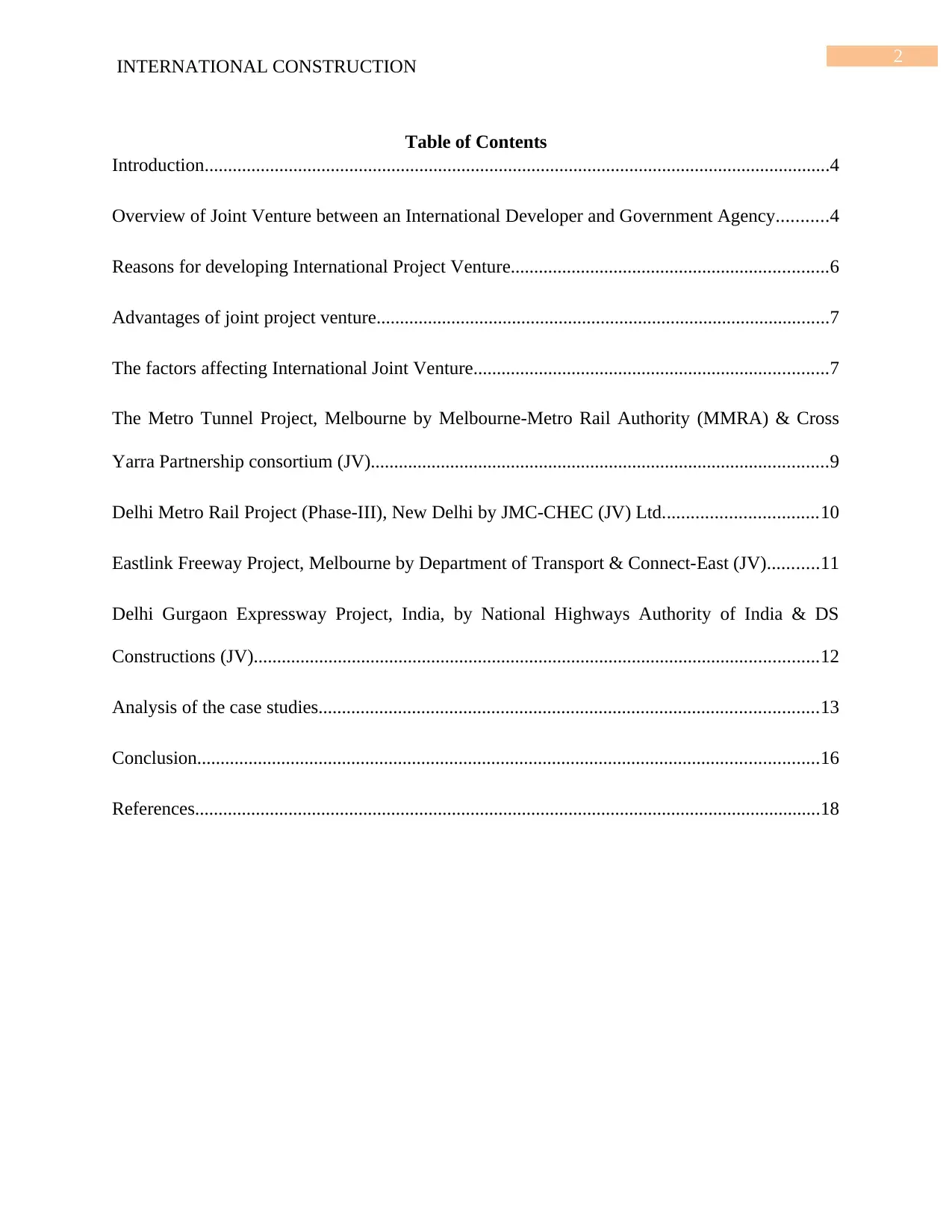
2
INTERNATIONAL CONSTRUCTION
Table of Contents
Introduction......................................................................................................................................4
Overview of Joint Venture between an International Developer and Government Agency...........4
Reasons for developing International Project Venture....................................................................6
Advantages of joint project venture.................................................................................................7
The factors affecting International Joint Venture............................................................................7
The Metro Tunnel Project, Melbourne by Melbourne-Metro Rail Authority (MMRA) & Cross
Yarra Partnership consortium (JV)..................................................................................................9
Delhi Metro Rail Project (Phase-III), New Delhi by JMC-CHEC (JV) Ltd.................................10
Eastlink Freeway Project, Melbourne by Department of Transport & Connect-East (JV)...........11
Delhi Gurgaon Expressway Project, India, by National Highways Authority of India & DS
Constructions (JV).........................................................................................................................12
Analysis of the case studies...........................................................................................................13
Conclusion.....................................................................................................................................16
References......................................................................................................................................18
INTERNATIONAL CONSTRUCTION
Table of Contents
Introduction......................................................................................................................................4
Overview of Joint Venture between an International Developer and Government Agency...........4
Reasons for developing International Project Venture....................................................................6
Advantages of joint project venture.................................................................................................7
The factors affecting International Joint Venture............................................................................7
The Metro Tunnel Project, Melbourne by Melbourne-Metro Rail Authority (MMRA) & Cross
Yarra Partnership consortium (JV)..................................................................................................9
Delhi Metro Rail Project (Phase-III), New Delhi by JMC-CHEC (JV) Ltd.................................10
Eastlink Freeway Project, Melbourne by Department of Transport & Connect-East (JV)...........11
Delhi Gurgaon Expressway Project, India, by National Highways Authority of India & DS
Constructions (JV).........................................................................................................................12
Analysis of the case studies...........................................................................................................13
Conclusion.....................................................................................................................................16
References......................................................................................................................................18
⊘ This is a preview!⊘
Do you want full access?
Subscribe today to unlock all pages.

Trusted by 1+ million students worldwide
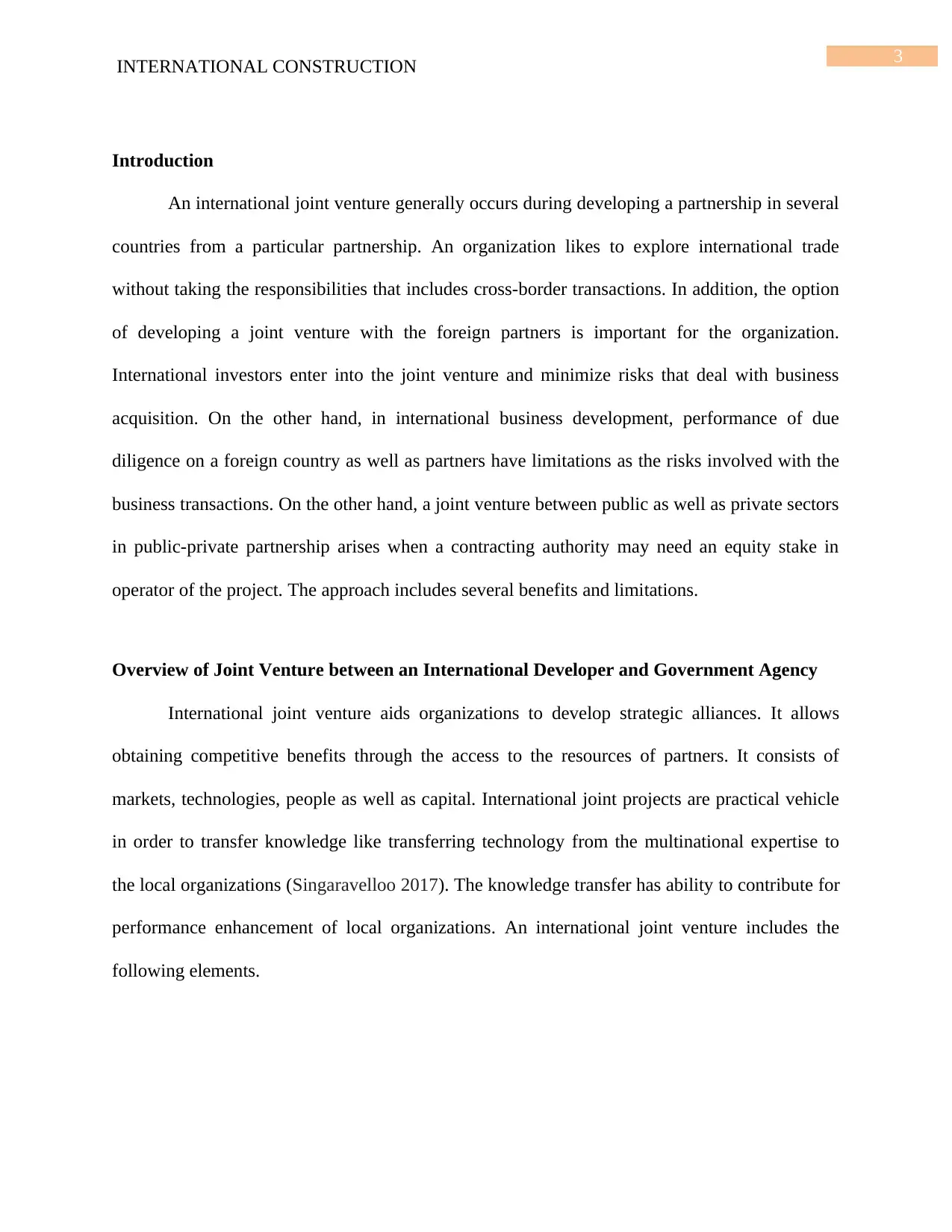
3
INTERNATIONAL CONSTRUCTION
Introduction
An international joint venture generally occurs during developing a partnership in several
countries from a particular partnership. An organization likes to explore international trade
without taking the responsibilities that includes cross-border transactions. In addition, the option
of developing a joint venture with the foreign partners is important for the organization.
International investors enter into the joint venture and minimize risks that deal with business
acquisition. On the other hand, in international business development, performance of due
diligence on a foreign country as well as partners have limitations as the risks involved with the
business transactions. On the other hand, a joint venture between public as well as private sectors
in public-private partnership arises when a contracting authority may need an equity stake in
operator of the project. The approach includes several benefits and limitations.
Overview of Joint Venture between an International Developer and Government Agency
International joint venture aids organizations to develop strategic alliances. It allows
obtaining competitive benefits through the access to the resources of partners. It consists of
markets, technologies, people as well as capital. International joint projects are practical vehicle
in order to transfer knowledge like transferring technology from the multinational expertise to
the local organizations (Singaravelloo 2017). The knowledge transfer has ability to contribute for
performance enhancement of local organizations. An international joint venture includes the
following elements.
INTERNATIONAL CONSTRUCTION
Introduction
An international joint venture generally occurs during developing a partnership in several
countries from a particular partnership. An organization likes to explore international trade
without taking the responsibilities that includes cross-border transactions. In addition, the option
of developing a joint venture with the foreign partners is important for the organization.
International investors enter into the joint venture and minimize risks that deal with business
acquisition. On the other hand, in international business development, performance of due
diligence on a foreign country as well as partners have limitations as the risks involved with the
business transactions. On the other hand, a joint venture between public as well as private sectors
in public-private partnership arises when a contracting authority may need an equity stake in
operator of the project. The approach includes several benefits and limitations.
Overview of Joint Venture between an International Developer and Government Agency
International joint venture aids organizations to develop strategic alliances. It allows
obtaining competitive benefits through the access to the resources of partners. It consists of
markets, technologies, people as well as capital. International joint projects are practical vehicle
in order to transfer knowledge like transferring technology from the multinational expertise to
the local organizations (Singaravelloo 2017). The knowledge transfer has ability to contribute for
performance enhancement of local organizations. An international joint venture includes the
following elements.
Paraphrase This Document
Need a fresh take? Get an instant paraphrase of this document with our AI Paraphraser
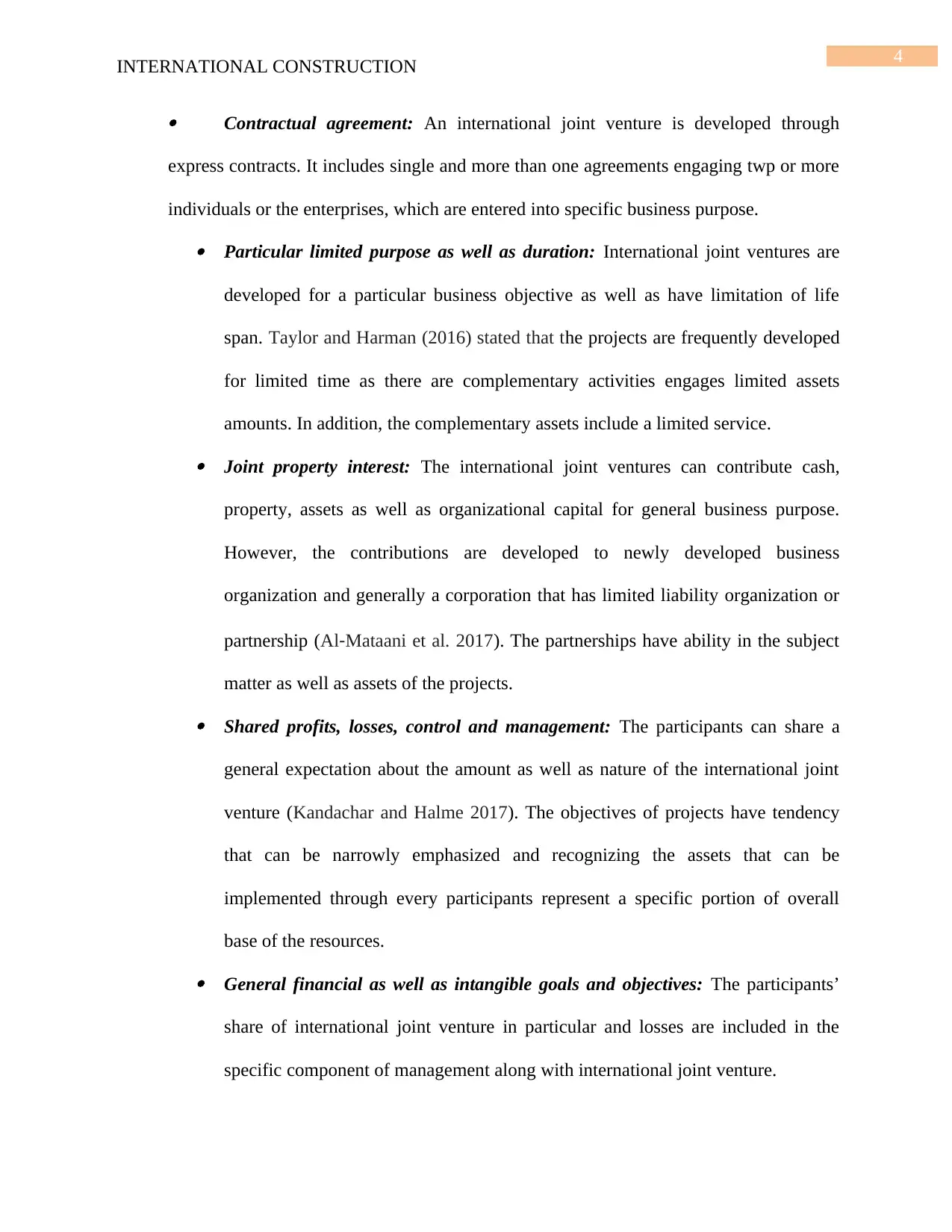
4
INTERNATIONAL CONSTRUCTION
Contractual agreement: An international joint venture is developed through
express contracts. It includes single and more than one agreements engaging twp or more
individuals or the enterprises, which are entered into specific business purpose.
Particular limited purpose as well as duration: International joint ventures are
developed for a particular business objective as well as have limitation of life
span. Taylor and Harman (2016) stated that the projects are frequently developed
for limited time as there are complementary activities engages limited assets
amounts. In addition, the complementary assets include a limited service.
Joint property interest: The international joint ventures can contribute cash,
property, assets as well as organizational capital for general business purpose.
However, the contributions are developed to newly developed business
organization and generally a corporation that has limited liability organization or
partnership (Al‐Mataani et al. 2017). The partnerships have ability in the subject
matter as well as assets of the projects.
Shared profits, losses, control and management: The participants can share a
general expectation about the amount as well as nature of the international joint
venture (Kandachar and Halme 2017). The objectives of projects have tendency
that can be narrowly emphasized and recognizing the assets that can be
implemented through every participants represent a specific portion of overall
base of the resources.
General financial as well as intangible goals and objectives: The participants’
share of international joint venture in particular and losses are included in the
specific component of management along with international joint venture.
INTERNATIONAL CONSTRUCTION
Contractual agreement: An international joint venture is developed through
express contracts. It includes single and more than one agreements engaging twp or more
individuals or the enterprises, which are entered into specific business purpose.
Particular limited purpose as well as duration: International joint ventures are
developed for a particular business objective as well as have limitation of life
span. Taylor and Harman (2016) stated that the projects are frequently developed
for limited time as there are complementary activities engages limited assets
amounts. In addition, the complementary assets include a limited service.
Joint property interest: The international joint ventures can contribute cash,
property, assets as well as organizational capital for general business purpose.
However, the contributions are developed to newly developed business
organization and generally a corporation that has limited liability organization or
partnership (Al‐Mataani et al. 2017). The partnerships have ability in the subject
matter as well as assets of the projects.
Shared profits, losses, control and management: The participants can share a
general expectation about the amount as well as nature of the international joint
venture (Kandachar and Halme 2017). The objectives of projects have tendency
that can be narrowly emphasized and recognizing the assets that can be
implemented through every participants represent a specific portion of overall
base of the resources.
General financial as well as intangible goals and objectives: The participants’
share of international joint venture in particular and losses are included in the
specific component of management along with international joint venture.
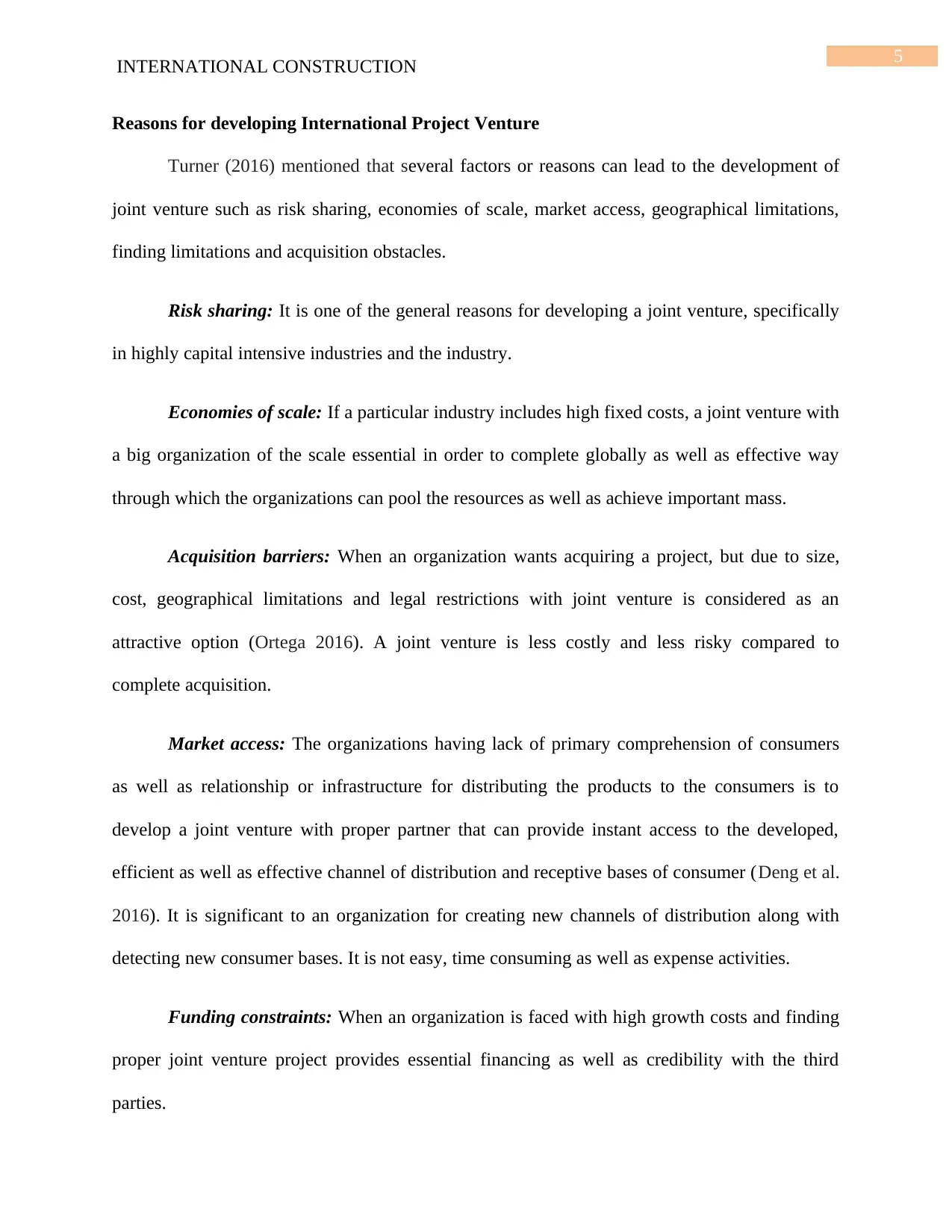
5
INTERNATIONAL CONSTRUCTION
Reasons for developing International Project Venture
Turner (2016) mentioned that several factors or reasons can lead to the development of
joint venture such as risk sharing, economies of scale, market access, geographical limitations,
finding limitations and acquisition obstacles.
Risk sharing: It is one of the general reasons for developing a joint venture, specifically
in highly capital intensive industries and the industry.
Economies of scale: If a particular industry includes high fixed costs, a joint venture with
a big organization of the scale essential in order to complete globally as well as effective way
through which the organizations can pool the resources as well as achieve important mass.
Acquisition barriers: When an organization wants acquiring a project, but due to size,
cost, geographical limitations and legal restrictions with joint venture is considered as an
attractive option (Ortega 2016). A joint venture is less costly and less risky compared to
complete acquisition.
Market access: The organizations having lack of primary comprehension of consumers
as well as relationship or infrastructure for distributing the products to the consumers is to
develop a joint venture with proper partner that can provide instant access to the developed,
efficient as well as effective channel of distribution and receptive bases of consumer (Deng et al.
2016). It is significant to an organization for creating new channels of distribution along with
detecting new consumer bases. It is not easy, time consuming as well as expense activities.
Funding constraints: When an organization is faced with high growth costs and finding
proper joint venture project provides essential financing as well as credibility with the third
parties.
INTERNATIONAL CONSTRUCTION
Reasons for developing International Project Venture
Turner (2016) mentioned that several factors or reasons can lead to the development of
joint venture such as risk sharing, economies of scale, market access, geographical limitations,
finding limitations and acquisition obstacles.
Risk sharing: It is one of the general reasons for developing a joint venture, specifically
in highly capital intensive industries and the industry.
Economies of scale: If a particular industry includes high fixed costs, a joint venture with
a big organization of the scale essential in order to complete globally as well as effective way
through which the organizations can pool the resources as well as achieve important mass.
Acquisition barriers: When an organization wants acquiring a project, but due to size,
cost, geographical limitations and legal restrictions with joint venture is considered as an
attractive option (Ortega 2016). A joint venture is less costly and less risky compared to
complete acquisition.
Market access: The organizations having lack of primary comprehension of consumers
as well as relationship or infrastructure for distributing the products to the consumers is to
develop a joint venture with proper partner that can provide instant access to the developed,
efficient as well as effective channel of distribution and receptive bases of consumer (Deng et al.
2016). It is significant to an organization for creating new channels of distribution along with
detecting new consumer bases. It is not easy, time consuming as well as expense activities.
Funding constraints: When an organization is faced with high growth costs and finding
proper joint venture project provides essential financing as well as credibility with the third
parties.
⊘ This is a preview!⊘
Do you want full access?
Subscribe today to unlock all pages.

Trusted by 1+ million students worldwide
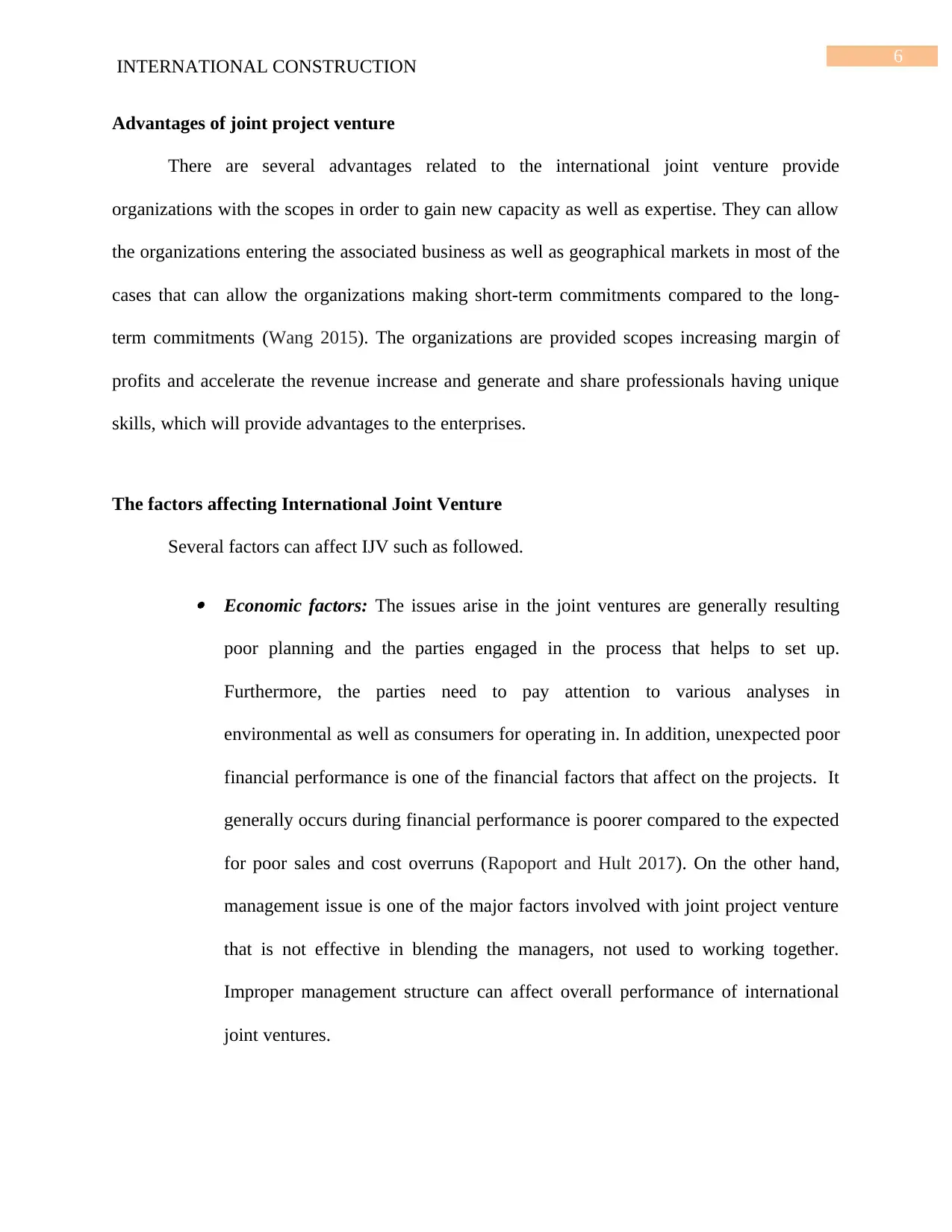
6
INTERNATIONAL CONSTRUCTION
Advantages of joint project venture
There are several advantages related to the international joint venture provide
organizations with the scopes in order to gain new capacity as well as expertise. They can allow
the organizations entering the associated business as well as geographical markets in most of the
cases that can allow the organizations making short-term commitments compared to the long-
term commitments (Wang 2015). The organizations are provided scopes increasing margin of
profits and accelerate the revenue increase and generate and share professionals having unique
skills, which will provide advantages to the enterprises.
The factors affecting International Joint Venture
Several factors can affect IJV such as followed. Economic factors: The issues arise in the joint ventures are generally resulting
poor planning and the parties engaged in the process that helps to set up.
Furthermore, the parties need to pay attention to various analyses in
environmental as well as consumers for operating in. In addition, unexpected poor
financial performance is one of the financial factors that affect on the projects. It
generally occurs during financial performance is poorer compared to the expected
for poor sales and cost overruns (Rapoport and Hult 2017). On the other hand,
management issue is one of the major factors involved with joint project venture
that is not effective in blending the managers, not used to working together.
Improper management structure can affect overall performance of international
joint ventures.
INTERNATIONAL CONSTRUCTION
Advantages of joint project venture
There are several advantages related to the international joint venture provide
organizations with the scopes in order to gain new capacity as well as expertise. They can allow
the organizations entering the associated business as well as geographical markets in most of the
cases that can allow the organizations making short-term commitments compared to the long-
term commitments (Wang 2015). The organizations are provided scopes increasing margin of
profits and accelerate the revenue increase and generate and share professionals having unique
skills, which will provide advantages to the enterprises.
The factors affecting International Joint Venture
Several factors can affect IJV such as followed. Economic factors: The issues arise in the joint ventures are generally resulting
poor planning and the parties engaged in the process that helps to set up.
Furthermore, the parties need to pay attention to various analyses in
environmental as well as consumers for operating in. In addition, unexpected poor
financial performance is one of the financial factors that affect on the projects. It
generally occurs during financial performance is poorer compared to the expected
for poor sales and cost overruns (Rapoport and Hult 2017). On the other hand,
management issue is one of the major factors involved with joint project venture
that is not effective in blending the managers, not used to working together.
Improper management structure can affect overall performance of international
joint ventures.
Paraphrase This Document
Need a fresh take? Get an instant paraphrase of this document with our AI Paraphraser
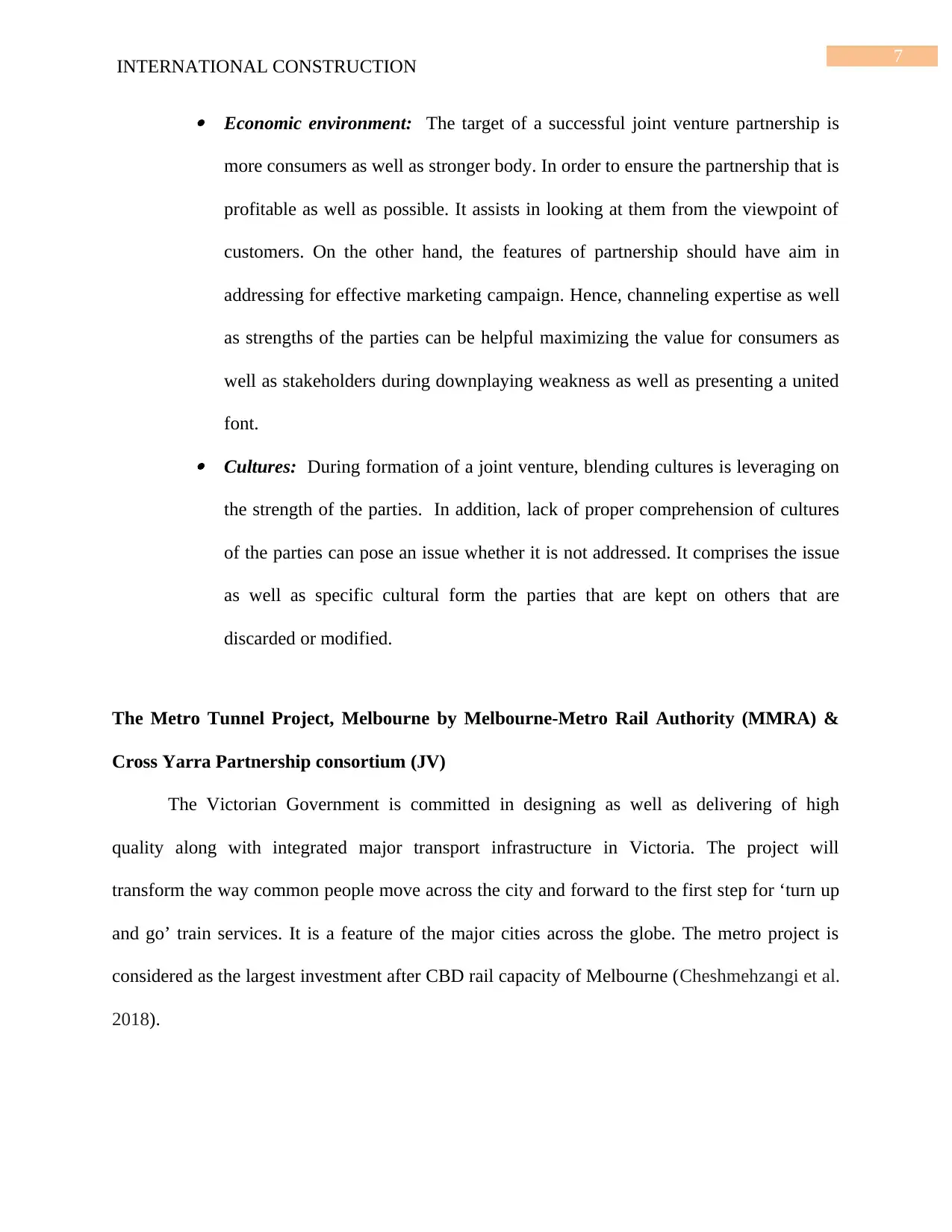
7
INTERNATIONAL CONSTRUCTION Economic environment: The target of a successful joint venture partnership is
more consumers as well as stronger body. In order to ensure the partnership that is
profitable as well as possible. It assists in looking at them from the viewpoint of
customers. On the other hand, the features of partnership should have aim in
addressing for effective marketing campaign. Hence, channeling expertise as well
as strengths of the parties can be helpful maximizing the value for consumers as
well as stakeholders during downplaying weakness as well as presenting a united
font.
Cultures: During formation of a joint venture, blending cultures is leveraging on
the strength of the parties. In addition, lack of proper comprehension of cultures
of the parties can pose an issue whether it is not addressed. It comprises the issue
as well as specific cultural form the parties that are kept on others that are
discarded or modified.
The Metro Tunnel Project, Melbourne by Melbourne-Metro Rail Authority (MMRA) &
Cross Yarra Partnership consortium (JV)
The Victorian Government is committed in designing as well as delivering of high
quality along with integrated major transport infrastructure in Victoria. The project will
transform the way common people move across the city and forward to the first step for ‘turn up
and go’ train services. It is a feature of the major cities across the globe. The metro project is
considered as the largest investment after CBD rail capacity of Melbourne (Cheshmehzangi et al.
2018).
INTERNATIONAL CONSTRUCTION Economic environment: The target of a successful joint venture partnership is
more consumers as well as stronger body. In order to ensure the partnership that is
profitable as well as possible. It assists in looking at them from the viewpoint of
customers. On the other hand, the features of partnership should have aim in
addressing for effective marketing campaign. Hence, channeling expertise as well
as strengths of the parties can be helpful maximizing the value for consumers as
well as stakeholders during downplaying weakness as well as presenting a united
font.
Cultures: During formation of a joint venture, blending cultures is leveraging on
the strength of the parties. In addition, lack of proper comprehension of cultures
of the parties can pose an issue whether it is not addressed. It comprises the issue
as well as specific cultural form the parties that are kept on others that are
discarded or modified.
The Metro Tunnel Project, Melbourne by Melbourne-Metro Rail Authority (MMRA) &
Cross Yarra Partnership consortium (JV)
The Victorian Government is committed in designing as well as delivering of high
quality along with integrated major transport infrastructure in Victoria. The project will
transform the way common people move across the city and forward to the first step for ‘turn up
and go’ train services. It is a feature of the major cities across the globe. The metro project is
considered as the largest investment after CBD rail capacity of Melbourne (Cheshmehzangi et al.
2018).
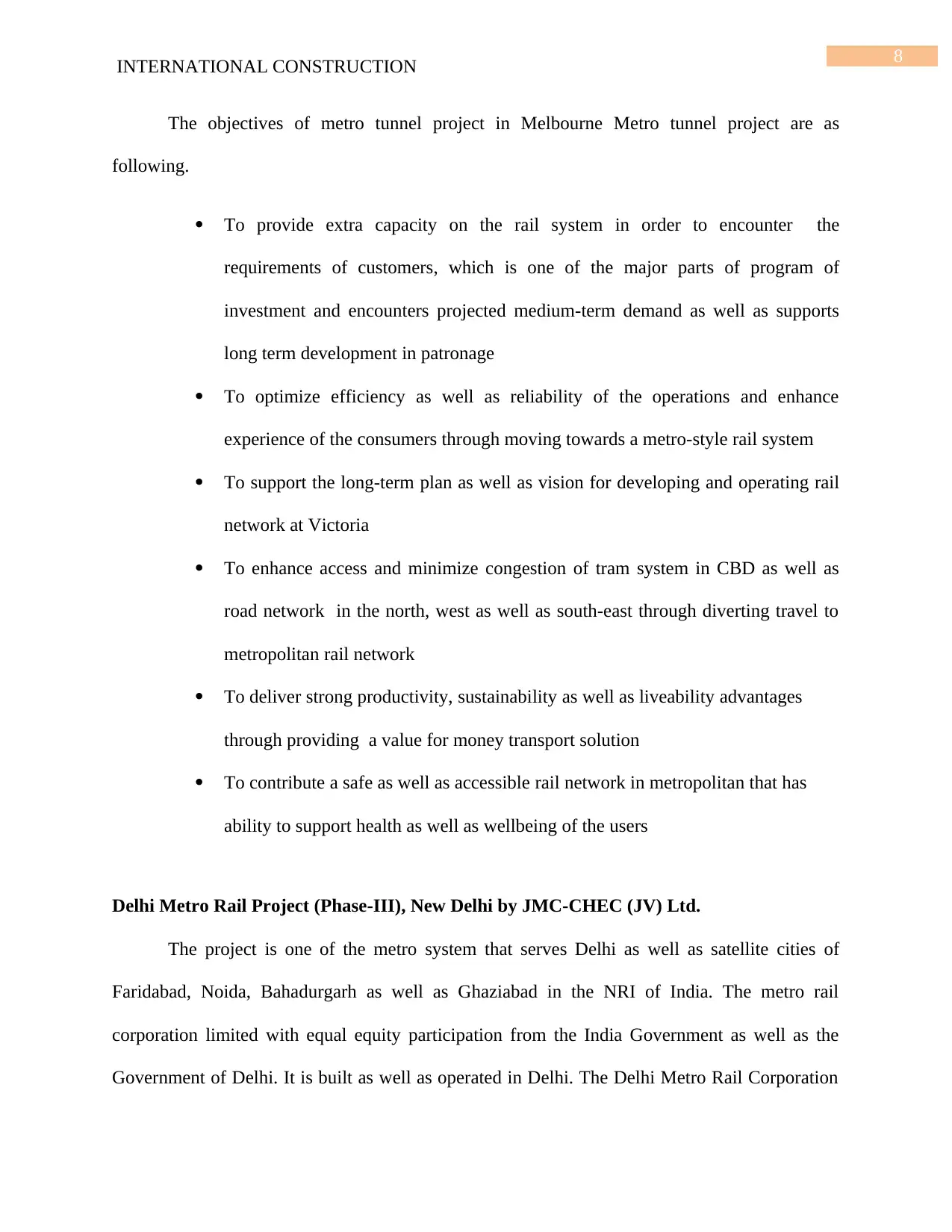
8
INTERNATIONAL CONSTRUCTION
The objectives of metro tunnel project in Melbourne Metro tunnel project are as
following.
To provide extra capacity on the rail system in order to encounter the
requirements of customers, which is one of the major parts of program of
investment and encounters projected medium-term demand as well as supports
long term development in patronage
To optimize efficiency as well as reliability of the operations and enhance
experience of the consumers through moving towards a metro-style rail system
To support the long-term plan as well as vision for developing and operating rail
network at Victoria
To enhance access and minimize congestion of tram system in CBD as well as
road network in the north, west as well as south-east through diverting travel to
metropolitan rail network
To deliver strong productivity, sustainability as well as liveability advantages
through providing a value for money transport solution
To contribute a safe as well as accessible rail network in metropolitan that has
ability to support health as well as wellbeing of the users
Delhi Metro Rail Project (Phase-III), New Delhi by JMC-CHEC (JV) Ltd.
The project is one of the metro system that serves Delhi as well as satellite cities of
Faridabad, Noida, Bahadurgarh as well as Ghaziabad in the NRI of India. The metro rail
corporation limited with equal equity participation from the India Government as well as the
Government of Delhi. It is built as well as operated in Delhi. The Delhi Metro Rail Corporation
INTERNATIONAL CONSTRUCTION
The objectives of metro tunnel project in Melbourne Metro tunnel project are as
following.
To provide extra capacity on the rail system in order to encounter the
requirements of customers, which is one of the major parts of program of
investment and encounters projected medium-term demand as well as supports
long term development in patronage
To optimize efficiency as well as reliability of the operations and enhance
experience of the consumers through moving towards a metro-style rail system
To support the long-term plan as well as vision for developing and operating rail
network at Victoria
To enhance access and minimize congestion of tram system in CBD as well as
road network in the north, west as well as south-east through diverting travel to
metropolitan rail network
To deliver strong productivity, sustainability as well as liveability advantages
through providing a value for money transport solution
To contribute a safe as well as accessible rail network in metropolitan that has
ability to support health as well as wellbeing of the users
Delhi Metro Rail Project (Phase-III), New Delhi by JMC-CHEC (JV) Ltd.
The project is one of the metro system that serves Delhi as well as satellite cities of
Faridabad, Noida, Bahadurgarh as well as Ghaziabad in the NRI of India. The metro rail
corporation limited with equal equity participation from the India Government as well as the
Government of Delhi. It is built as well as operated in Delhi. The Delhi Metro Rail Corporation
⊘ This is a preview!⊘
Do you want full access?
Subscribe today to unlock all pages.

Trusted by 1+ million students worldwide
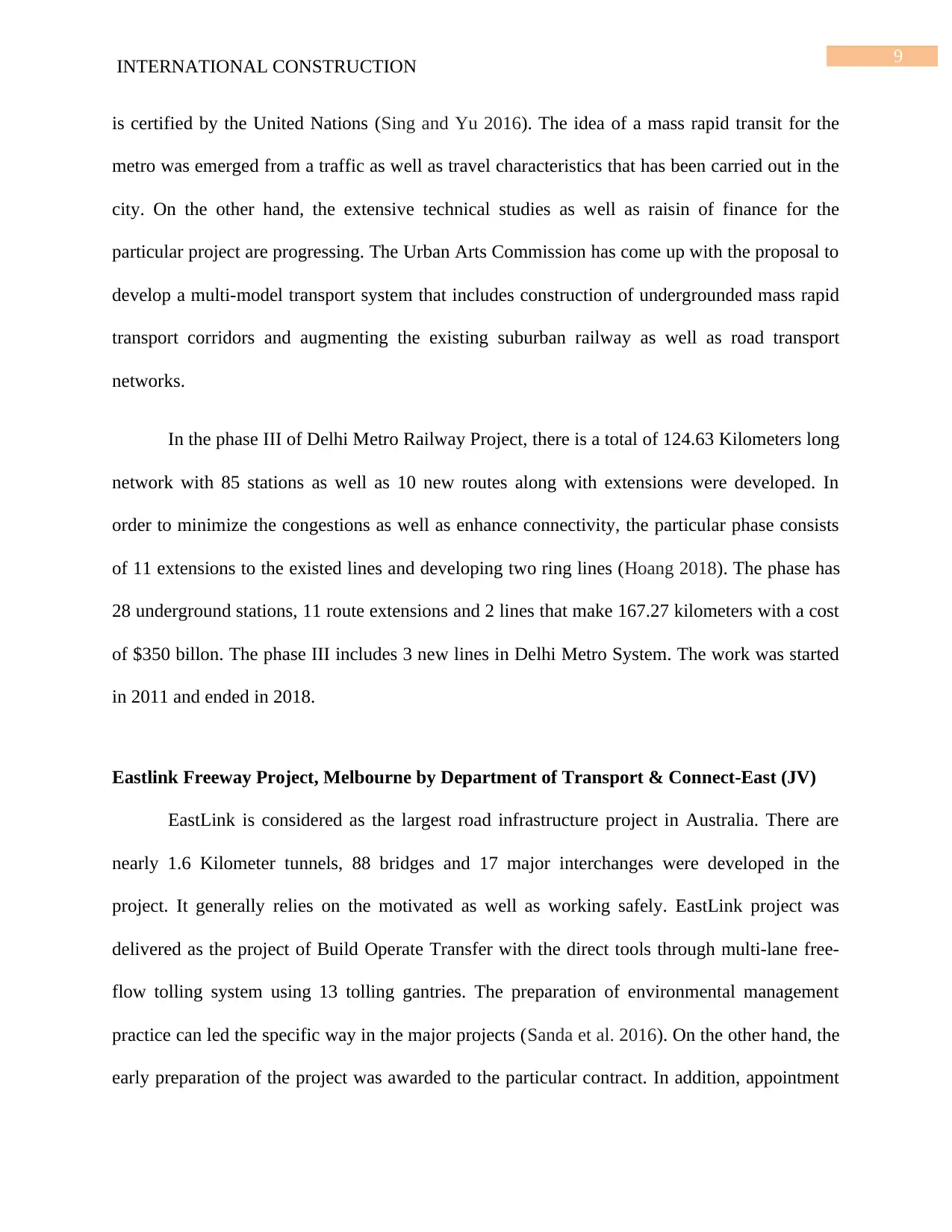
9
INTERNATIONAL CONSTRUCTION
is certified by the United Nations (Sing and Yu 2016). The idea of a mass rapid transit for the
metro was emerged from a traffic as well as travel characteristics that has been carried out in the
city. On the other hand, the extensive technical studies as well as raisin of finance for the
particular project are progressing. The Urban Arts Commission has come up with the proposal to
develop a multi-model transport system that includes construction of undergrounded mass rapid
transport corridors and augmenting the existing suburban railway as well as road transport
networks.
In the phase III of Delhi Metro Railway Project, there is a total of 124.63 Kilometers long
network with 85 stations as well as 10 new routes along with extensions were developed. In
order to minimize the congestions as well as enhance connectivity, the particular phase consists
of 11 extensions to the existed lines and developing two ring lines (Hoang 2018). The phase has
28 underground stations, 11 route extensions and 2 lines that make 167.27 kilometers with a cost
of $350 billon. The phase III includes 3 new lines in Delhi Metro System. The work was started
in 2011 and ended in 2018.
Eastlink Freeway Project, Melbourne by Department of Transport & Connect-East (JV)
EastLink is considered as the largest road infrastructure project in Australia. There are
nearly 1.6 Kilometer tunnels, 88 bridges and 17 major interchanges were developed in the
project. It generally relies on the motivated as well as working safely. EastLink project was
delivered as the project of Build Operate Transfer with the direct tools through multi-lane free-
flow tolling system using 13 tolling gantries. The preparation of environmental management
practice can led the specific way in the major projects (Sanda et al. 2016). On the other hand, the
early preparation of the project was awarded to the particular contract. In addition, appointment
INTERNATIONAL CONSTRUCTION
is certified by the United Nations (Sing and Yu 2016). The idea of a mass rapid transit for the
metro was emerged from a traffic as well as travel characteristics that has been carried out in the
city. On the other hand, the extensive technical studies as well as raisin of finance for the
particular project are progressing. The Urban Arts Commission has come up with the proposal to
develop a multi-model transport system that includes construction of undergrounded mass rapid
transport corridors and augmenting the existing suburban railway as well as road transport
networks.
In the phase III of Delhi Metro Railway Project, there is a total of 124.63 Kilometers long
network with 85 stations as well as 10 new routes along with extensions were developed. In
order to minimize the congestions as well as enhance connectivity, the particular phase consists
of 11 extensions to the existed lines and developing two ring lines (Hoang 2018). The phase has
28 underground stations, 11 route extensions and 2 lines that make 167.27 kilometers with a cost
of $350 billon. The phase III includes 3 new lines in Delhi Metro System. The work was started
in 2011 and ended in 2018.
Eastlink Freeway Project, Melbourne by Department of Transport & Connect-East (JV)
EastLink is considered as the largest road infrastructure project in Australia. There are
nearly 1.6 Kilometer tunnels, 88 bridges and 17 major interchanges were developed in the
project. It generally relies on the motivated as well as working safely. EastLink project was
delivered as the project of Build Operate Transfer with the direct tools through multi-lane free-
flow tolling system using 13 tolling gantries. The preparation of environmental management
practice can led the specific way in the major projects (Sanda et al. 2016). On the other hand, the
early preparation of the project was awarded to the particular contract. In addition, appointment
Paraphrase This Document
Need a fresh take? Get an instant paraphrase of this document with our AI Paraphraser
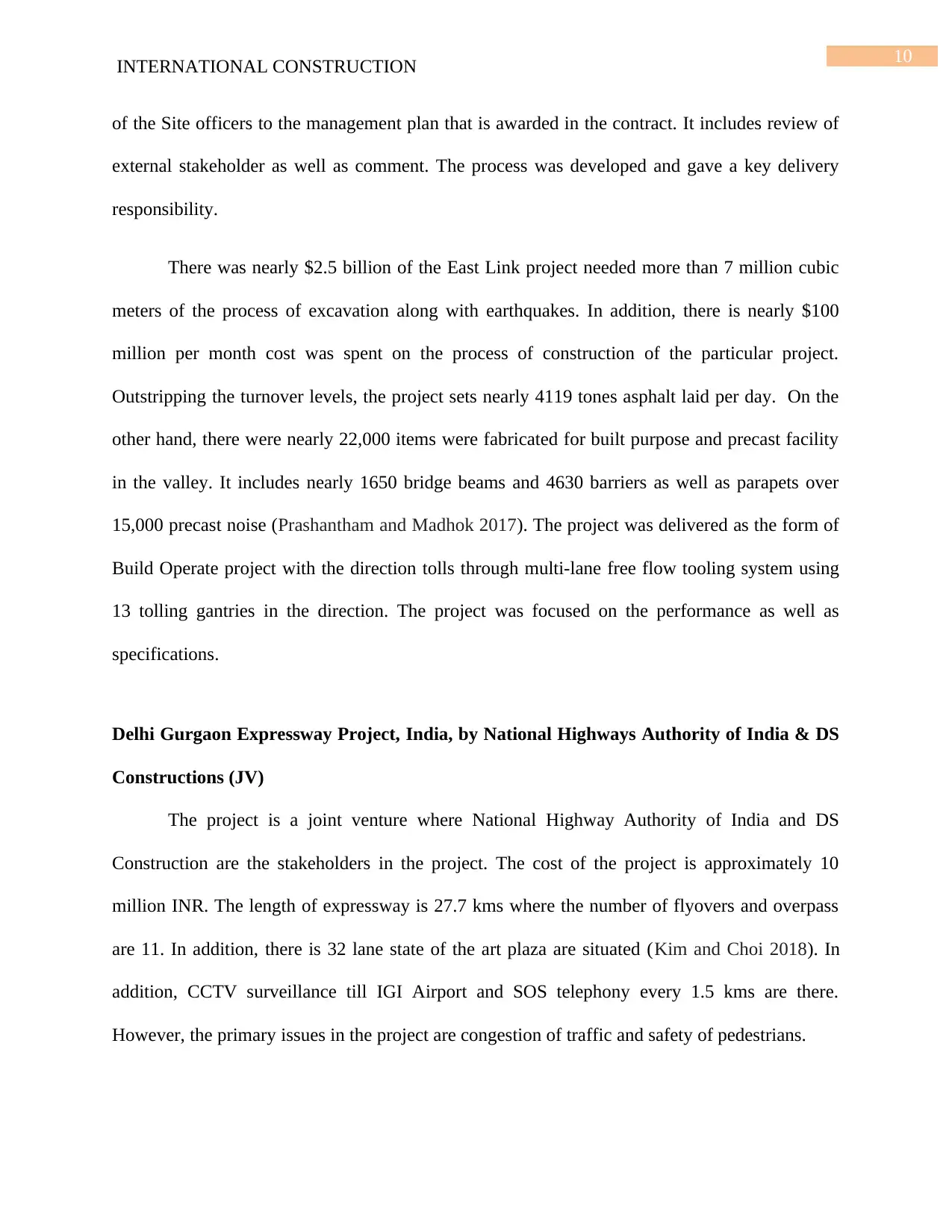
10
INTERNATIONAL CONSTRUCTION
of the Site officers to the management plan that is awarded in the contract. It includes review of
external stakeholder as well as comment. The process was developed and gave a key delivery
responsibility.
There was nearly $2.5 billion of the East Link project needed more than 7 million cubic
meters of the process of excavation along with earthquakes. In addition, there is nearly $100
million per month cost was spent on the process of construction of the particular project.
Outstripping the turnover levels, the project sets nearly 4119 tones asphalt laid per day. On the
other hand, there were nearly 22,000 items were fabricated for built purpose and precast facility
in the valley. It includes nearly 1650 bridge beams and 4630 barriers as well as parapets over
15,000 precast noise (Prashantham and Madhok 2017). The project was delivered as the form of
Build Operate project with the direction tolls through multi-lane free flow tooling system using
13 tolling gantries in the direction. The project was focused on the performance as well as
specifications.
Delhi Gurgaon Expressway Project, India, by National Highways Authority of India & DS
Constructions (JV)
The project is a joint venture where National Highway Authority of India and DS
Construction are the stakeholders in the project. The cost of the project is approximately 10
million INR. The length of expressway is 27.7 kms where the number of flyovers and overpass
are 11. In addition, there is 32 lane state of the art plaza are situated (Kim and Choi 2018). In
addition, CCTV surveillance till IGI Airport and SOS telephony every 1.5 kms are there.
However, the primary issues in the project are congestion of traffic and safety of pedestrians.
INTERNATIONAL CONSTRUCTION
of the Site officers to the management plan that is awarded in the contract. It includes review of
external stakeholder as well as comment. The process was developed and gave a key delivery
responsibility.
There was nearly $2.5 billion of the East Link project needed more than 7 million cubic
meters of the process of excavation along with earthquakes. In addition, there is nearly $100
million per month cost was spent on the process of construction of the particular project.
Outstripping the turnover levels, the project sets nearly 4119 tones asphalt laid per day. On the
other hand, there were nearly 22,000 items were fabricated for built purpose and precast facility
in the valley. It includes nearly 1650 bridge beams and 4630 barriers as well as parapets over
15,000 precast noise (Prashantham and Madhok 2017). The project was delivered as the form of
Build Operate project with the direction tolls through multi-lane free flow tooling system using
13 tolling gantries in the direction. The project was focused on the performance as well as
specifications.
Delhi Gurgaon Expressway Project, India, by National Highways Authority of India & DS
Constructions (JV)
The project is a joint venture where National Highway Authority of India and DS
Construction are the stakeholders in the project. The cost of the project is approximately 10
million INR. The length of expressway is 27.7 kms where the number of flyovers and overpass
are 11. In addition, there is 32 lane state of the art plaza are situated (Kim and Choi 2018). In
addition, CCTV surveillance till IGI Airport and SOS telephony every 1.5 kms are there.
However, the primary issues in the project are congestion of traffic and safety of pedestrians.
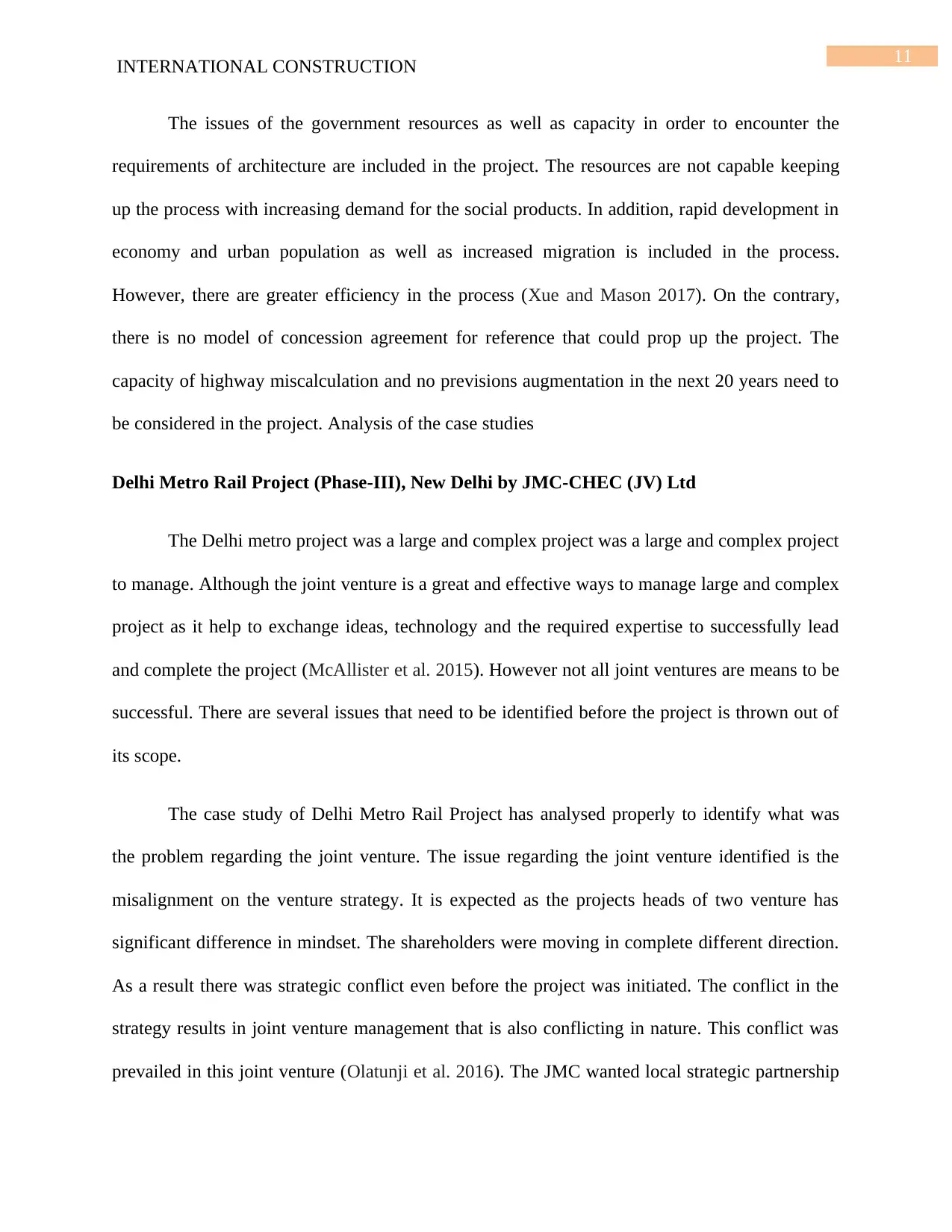
11
INTERNATIONAL CONSTRUCTION
The issues of the government resources as well as capacity in order to encounter the
requirements of architecture are included in the project. The resources are not capable keeping
up the process with increasing demand for the social products. In addition, rapid development in
economy and urban population as well as increased migration is included in the process.
However, there are greater efficiency in the process (Xue and Mason 2017). On the contrary,
there is no model of concession agreement for reference that could prop up the project. The
capacity of highway miscalculation and no previsions augmentation in the next 20 years need to
be considered in the project. Analysis of the case studies
Delhi Metro Rail Project (Phase-III), New Delhi by JMC-CHEC (JV) Ltd
The Delhi metro project was a large and complex project was a large and complex project
to manage. Although the joint venture is a great and effective ways to manage large and complex
project as it help to exchange ideas, technology and the required expertise to successfully lead
and complete the project (McAllister et al. 2015). However not all joint ventures are means to be
successful. There are several issues that need to be identified before the project is thrown out of
its scope.
The case study of Delhi Metro Rail Project has analysed properly to identify what was
the problem regarding the joint venture. The issue regarding the joint venture identified is the
misalignment on the venture strategy. It is expected as the projects heads of two venture has
significant difference in mindset. The shareholders were moving in complete different direction.
As a result there was strategic conflict even before the project was initiated. The conflict in the
strategy results in joint venture management that is also conflicting in nature. This conflict was
prevailed in this joint venture (Olatunji et al. 2016). The JMC wanted local strategic partnership
INTERNATIONAL CONSTRUCTION
The issues of the government resources as well as capacity in order to encounter the
requirements of architecture are included in the project. The resources are not capable keeping
up the process with increasing demand for the social products. In addition, rapid development in
economy and urban population as well as increased migration is included in the process.
However, there are greater efficiency in the process (Xue and Mason 2017). On the contrary,
there is no model of concession agreement for reference that could prop up the project. The
capacity of highway miscalculation and no previsions augmentation in the next 20 years need to
be considered in the project. Analysis of the case studies
Delhi Metro Rail Project (Phase-III), New Delhi by JMC-CHEC (JV) Ltd
The Delhi metro project was a large and complex project was a large and complex project
to manage. Although the joint venture is a great and effective ways to manage large and complex
project as it help to exchange ideas, technology and the required expertise to successfully lead
and complete the project (McAllister et al. 2015). However not all joint ventures are means to be
successful. There are several issues that need to be identified before the project is thrown out of
its scope.
The case study of Delhi Metro Rail Project has analysed properly to identify what was
the problem regarding the joint venture. The issue regarding the joint venture identified is the
misalignment on the venture strategy. It is expected as the projects heads of two venture has
significant difference in mindset. The shareholders were moving in complete different direction.
As a result there was strategic conflict even before the project was initiated. The conflict in the
strategy results in joint venture management that is also conflicting in nature. This conflict was
prevailed in this joint venture (Olatunji et al. 2016). The JMC wanted local strategic partnership
⊘ This is a preview!⊘
Do you want full access?
Subscribe today to unlock all pages.

Trusted by 1+ million students worldwide
1 out of 20
Your All-in-One AI-Powered Toolkit for Academic Success.
+13062052269
info@desklib.com
Available 24*7 on WhatsApp / Email
![[object Object]](/_next/static/media/star-bottom.7253800d.svg)
Unlock your academic potential
Copyright © 2020–2025 A2Z Services. All Rights Reserved. Developed and managed by ZUCOL.